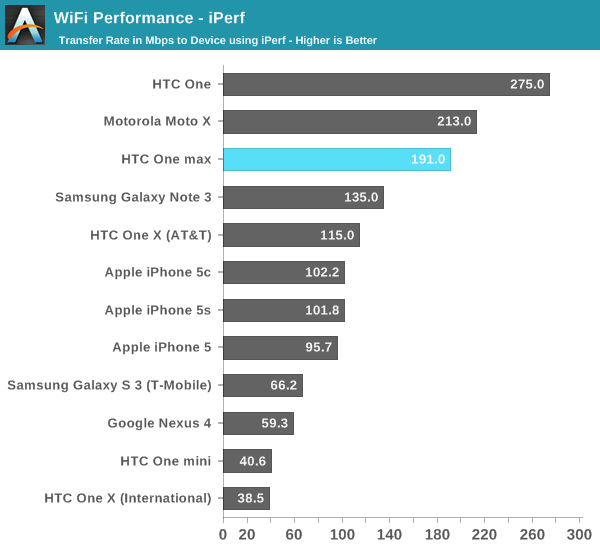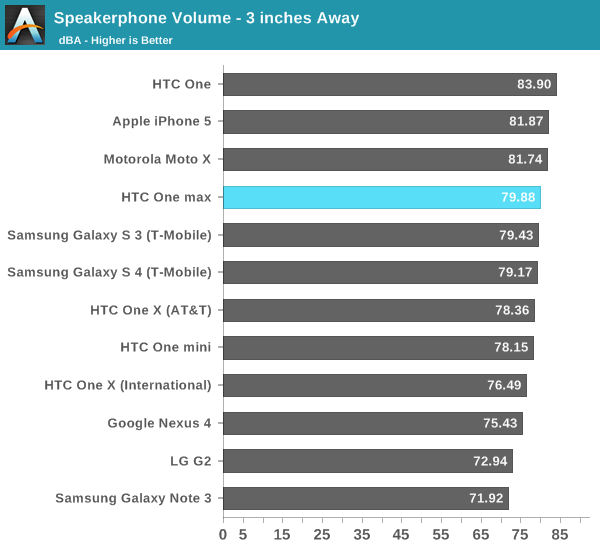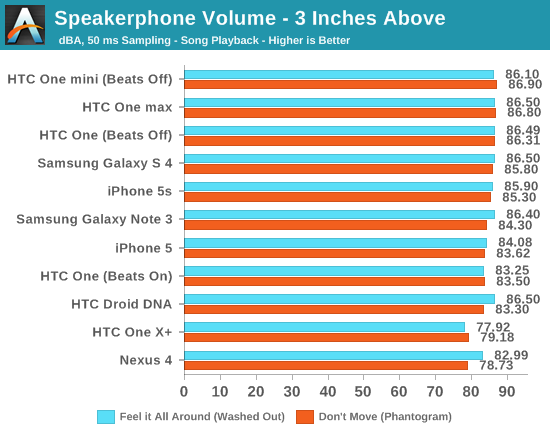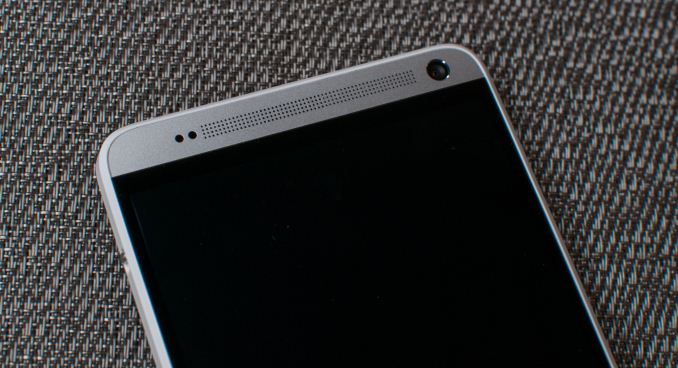HTC One max Review - It's Huge
by Brian Klug on October 28, 2013 10:00 AM EST- Posted in
- Smartphones
- HTC
- Mobile
- One
- Snapdragon 600
- Android 4.3
- One max
Cellular
Cellular on the One max is pretty much the same story as the One, and another shared bullet point. The top and bottom metal cutouts are still the radiative surfaces of the antenna, and there’s still transmit and receive diversity as well to mitigate any unwarranted antenna detuning from holding the device. The unit I was sampled has LTE banding for EMEA (Europe, Middle East, and Africa), but there’s appropriate banding for Asia, Sprint (a tri-mode device with 800/1900 MHz and TDD-LTE on 2600 MHz) and Verizon (700 MHz and AWS), according to the HTC specs page.
The baseband inside the One max is again shared with the One (Qualcomm’s 2nd generation multimode LTE MDM9x15 family), although the One max does have a bit more band support for the USA LTE on Sprint and Verizon, so the front ends are different.
WiFi
Interestingly enough with the One max we see HTC going to Qualcomm Atheros for the WLAN and BT combo, best I can tell this is the WCN3680 which is probably a bit cheaper to include than the BCM4335 we saw in the One. It’s still a single spatial stream 802.11ac capable part, meaning a PHY rate of up to 433 Mbps if you’re in the right channel conditions with 80 MHz channels on 5 GHz. The WCN3680 combo is the 802.11ac successor to WCN3660 which we saw in a number of phones last generation, and is accelerated by the SoC. WCN3680 also does BT 4.0, and FM Rx/Tx if applicable.

To test throughput on the One max I used iPerf the same way I have for a while now. Subjectively there are no complaints from me about WLAN connectivity on the One max, no random dropouts or issues, and Sense 5.5 thankfully still includes the WiFi frequency band manual selection option.
I saw the WCN3680 solution inside Moto X already, it’s interesting to see it in the One max. I believe the One mini uses its 802.11n cousin, WCN3660 as well, probably again for cost reasons.
Speakerphone
Although Beats is gone since that partnership has ended as of the One max, the device still seems to retain everything that made it sound great. There are still the larger-than-typical speaker chambers, big speaker grilles on the top and bottom, stereo sound, and importantly the TFA9887 speaker amplifier and protection part from NXP. In addition there’s still the TPA6185 headphone amplifier as well.
Beats always seemed to be an audio compressor that ran on the DSP, ostensibly through the Hexagon DSP access program or something, and that’s what’s absent on the One max. There’s no toggle under settings for enabling or disabling it, nor the Beats branding, but to be honest I almost always disabled Beats on the One anyways since it was a fair amount louder with it disabled. What made the One great was all the hardware behind the speakers, not so much the software compressor.


The One max goes plenty loud just like the original One. I went ahead and added the One mini and 5s to the chart too, just to check whether things have changed much, in addition to the Galaxy S 4 and Note 3. The One max basically performs like the One with Beats turned off, which isn’t a surprise since it isn’t there anymore. There’s also no detectable saturation, and the One line remains the only device that doesn’t sound tinny or rattly with overemphasized highs and lacking mids. I suspect the A weighting I selected a while ago for measuring might be a contributing factor as well. Either way you’re not going to be wanting for more loudness on the One max, and the inclusion of front firing stereo speakers makes for a completely different listening experience.












197 Comments
View All Comments
BlakKW - Monday, October 28, 2013 - link
+2cbrownx88 - Monday, October 28, 2013 - link
+3MarcSP - Monday, October 28, 2013 - link
+4hrrmph - Tuesday, October 29, 2013 - link
+5The Saint - Monday, October 28, 2013 - link
"I’ve said my part already on microSD cards and the fact that they’re going the way of the dodo in smartphones, I just don’t need one anymore, and definitely not at the expense of build quality. It is convenient not having to use a SIM ejector tool though, even if I carry one around all the time anyways. For the incredibly small percentage of users that clamors for an SD card every single smartphone launch, it’s at least one point which won’t be belabored so tiresomely this time."That's funny. Seems to me if there's one thing that seems to be going the way of the dodo, it's Android manufacturers like HTC who think prettiness and premium feel are more important than functionality. It will be nice once they go out of business to be able to stop hearing from that tiresome segment of pretend geeks who treat their cellphones like how divas treat their purses - as fashion accessories.
Meanwhile, Samsung will continue laughing by being both the only player that focuses on functionality, and the only player that makes money in the Android world.
nerd1 - Monday, October 28, 2013 - link
Apple charges $100 for 16GB memory and you can find 32GB micro SD at around $15. I wonder why most reviewers conveniently ignore this fact and just compare the baseline price of the products. I can do the math and I won't buy any device without expandability.Drumsticks - Monday, October 28, 2013 - link
I'm not sure that expandibility is the biggest selling point for galaxy phones outside of tech enthusiasts. Most people are not movie hogs etc and find 32GB reasonable. Business users and media enthusiasts on the other hand, would. But they don't represent everyone. Especially with streaming.I think its more brand name appeal and how much more recognizable they are. After all, apple does even better, and its not like they've ever offered MicroSD support.
personally I just think 16GB needs to die, and 32 should be standard up to 128GB in $50 increments max using high quality flash.
Spunjji - Monday, October 28, 2013 - link
Agreed about 16GB needing to die. But why would it when plenty of companies still make an extra $100 per sale by forcing people to upgrade to the minimum serviceable level? At least the Micro SD slot, with all its failings, allows some sort of other option. "pay as you grow" instead of throwing the whole shebang away when your storage needs outpace the crappy little chip soldered into your device.The0ne - Monday, October 28, 2013 - link
My decision on a phone is1. Screen size and resolution
2. MicroSD slot
I use my phone more as a e-reader and media device than a phone. That's not to say I don't use it as a phone normall, I do but it's not all that it does. Duh? Having the MicroSD slot for expansion is Godsend. All my books and technical PDF's are there. All my music, videos and photos are there (just the favorite ones), and so forth.
Why wouldn't you want to have all of those on your phone? It is convenience for me. One device to do what I like to use it for.
Davidjan - Tuesday, October 29, 2013 - link
Agree with you. We can use OTG reader to expand storage like Meenova MicroSD Reader if we want: http://goo.gl/U6IyY